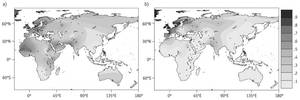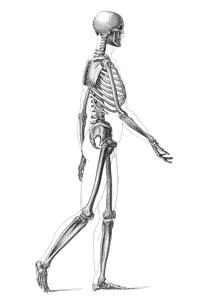Milk? No, thank you
2013/10/01 Zabala Agirre, Larraitz - Biologian lizentziatua | Arrieta Aseginolaza, Maialen - Biologian lizentziatua Iturria: Elhuyar aldizkaria

In the newborn, most mammals have a high activity of the enzyme lactase, which allows to drink breast milk. As we grow, this activity is decreasing and most adult mammals do not have active enzymes such as lactase, so they have symptoms such as diarrhea when drinking milk.
Taking this into account, we can think that our ancestors could not drink milk either, so the fact of being able to drink milk in adulthood is a novel feature, that is, 10,000 years ago we acquired the sustainability of lactase activity. But how did we get there?
The key is in genetics. In order for milk to be drunk smoothly, it is necessary to degrade a sugar, lactose, which only contains, and for this purpose it is considered that the capacity is in a specific nucleotide located above the area where the lactase enzyme gene is located. This characteristic, besides being a dominant hereditary pattern, has a complete penetrability, that is, if it appears in the genome the consequences of this characteristic are observed (Ingram et al ., 2009).
Therefore, according to this mutation, people can be of two types. On the one hand, 25% of the population has a sustained tolerance to lactose, that is, it maintains a high activity of lactase in the adult age, which does not pose any problem to drink and assimilate milk in the adult age. On the other hand, the majority of the population, 75%, presents a non-permanent tolerance to lactose, which, like in other mammals, have in their maturity an inhibited lactase that cannot be degraded. In the latter, lactose reaches the colon as a disaccharide and may present problems of diarrhea and/or calcium absorption.
The frequency of this characteristic is not the same for populations around the world. The highest rates of lactase persistence are in northern Europe (83% in Finland, 95% in Scandinavia and 85% in England and Germany). High frequencies (80%) are also observed in Africa and the tribes of the deserts of Arabia. The lowest frequencies are given in eastern Eurasia (in the Asian centre > 10% and in southern India 30%) (Geraldine, 2005).
Culprit culture
Among the hypotheses that explain the distribution of the sustainability of lactase worldwide, the most important is the hypothesis of historical culture. According to this, the increase in the sustainability of lactase coevolved with the adaptation of society to milk consumption. That is, the persistence with lactose was increasing as milk became part of the diet.
According to this hypothesis, modern man would have two types of ancestors. On the one hand, those who would be hunter-gatherers and farmers, and on the other, those who specialized in livestock. About 300 generations ago, the populations that began to domesticate cattle introduced milk into their diet. To do this, due to the need to be persistent with lactose, it is considered that some individuals already had mutation. As the mutation represented an advantage, being able to feed, it is believed that there was a positive selection in his favor. In this way, little by little, milk production was increasing and, due to the nutritional advantages offered by milk, the sustainability of lactase was expanded.
However, as will be explained, there are exceptions of ethnic groups that cannot be explained with this hypothesis, such as dincas and daughters-in-law in Sudan and somals in Ethiopia (Ingram et al., 2009).
But what would be the mutation of the initial livestock populations?
In spite of the numerous studies carried out around the sustainability of lactase, and that the scientists have quite clear which can be the location of the mutation, at present it is not completely defined what is the concrete mechanism that has allowed the digestion of lactose in the adult age.
The first research on the variations in lactase enzyme activity was carried out in Europe. For this reason, initially it was thought that the only and direct cause of the sustainability of lactase was the substitution of a nucleotide. In this mutation the thymine appears in the place of a cytosine. C>The mutation called T 13.910 is located at 13.9 Kb above the lactase gene, in an intron of the MCM6 gene (i.e., zone does not encode proteins) (Figure 1) (Ingram et al., 2009).
Knowing the function of the MCM6 gene (regulation of DNA duplication), and seeing that it has nothing to do with the function of the lactase gene, Olds and Sibley (2003) consider that the DNA sequence in which the C>T 13.910 mutation is located has two functions: on the one hand, acting as an intron of the MCM6 gene, but on the other hand being a regulator.

Based on this, two sets of characteristics have been defined, which are transmitted in Europe together with the inheritance: Haplotype C 13.910, lactose-intolerant in adulthood, and Haplotype T 13.910, with permanent tolerance to lactose.
Although initially it was admitted that the distribution of lactase persistence in Europe and that of haplotype T 13.910 were totally overlapping, the research carried out by the Ingram group (2009) took this hypothesis. In his opinion, the distribution of both characteristics is not at all coincident (figure 2), so they reached a clear conclusion: C>That mutation T 13.910 is not the only direct and direct cause that allows the sustainable activity of lactase.
In addition, in recent years, populations of Sub-Saharan Africa have been investigated, which have consumed milk throughout history. Since these populations are tolerant of milk, the European mutation was expected to be found, but contrary results were obtained. For this reason, it was recognized that the persistence of lactase arose from diverse mutations and in geographically distributed places.
Following this line of research, new mutations have been found in 3 KB around the mutation C>T 13.910 (Table 1).
Taking into account all these data, as mentioned at the beginning, although there are clear indications, it is still not known exactly what is the mutation that has produced the persistence of lactose. Therefore, it can be said that more research is needed.
How did sustainability spread with lactose across Europe?
DNA studies on dated bones at the beginning of Neolithic indicate that the frequency of haplotype T 13.910 was very low. In this way, it is recognized that at this time the persistence of lactose had not yet been developed.
With the introduction of Neolithic culture in Europe (6,256-8,663 years ago), livestock and dairy production were developed. Due to this development, natural selection began to occur in favor of the already existing haplotype T 13.910 to adapt to the dairy culture that was spreading. The first manifestations of the persistence of lactase took place in the north of the Balkans, and as the Neolithic culture spread through Europe, the ability to digest lactose from milk (Itan et al., 2009).
As Itan and his companions have shown, Neolithic culture acquired great strength, along with livestock and dairy production. In the end, 6,500 years ago it became the economic base of European societies, giving a very positive selection in favor of the sustainability of lactase.
Key: intestinal flora
With the aim of explaining the difference between the sustainability of lactase in world populations, other hypotheses have been formulated, such as intestinal flora. The existence of populations (dincas and nutmeg in Sudan and somals in Ethiopia) that were not resolved by the hypothesis of historical culture, that is to say, in all the populations dedicated to the livestock there is not observed a mutation generating the lactase, they raised the hypothesis that it is an intestinal flora. The clearest example is Somalia, where they drink milk but are not lacto-persistent. According to this hypothesis, the flora found in the colon allows the digestion of lactose.
Tolerance to lactose of some adult humans is a clear example of the influence of culture on a society. Protecting the engines of evolution, the cultural revolution has changed the genetics of the human being and has acquired the ability to drink milk. However, although most populations around the world have milk? No, thanks to the question, those who can drink milk do not realize that we are the minority of the population. Although it seems ironic, in our society the food industry works looking at those who are a minority, incorporating milk in many foods, preventing the end of ignorance in this matter.
Bibliography Bibliography Bibliography

Gai honi buruzko eduki gehiago
Elhuyarrek garatutako teknologia







